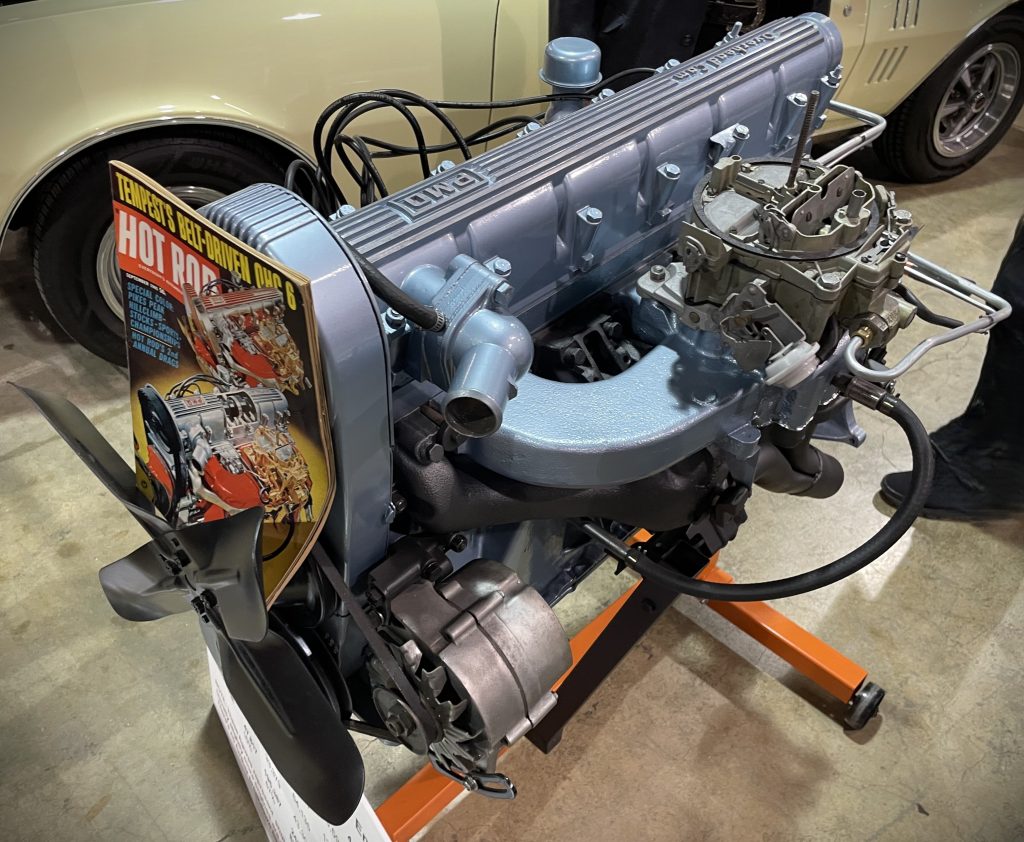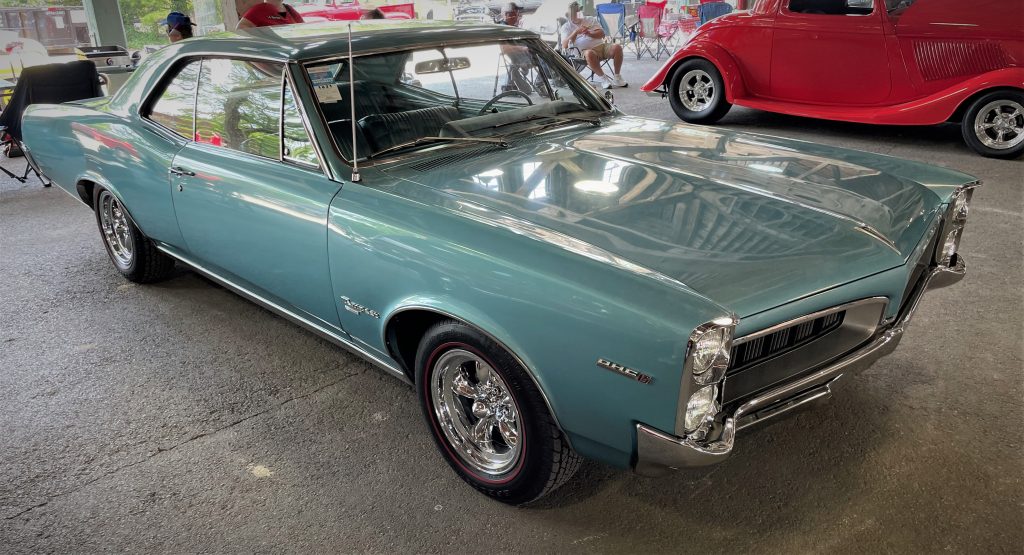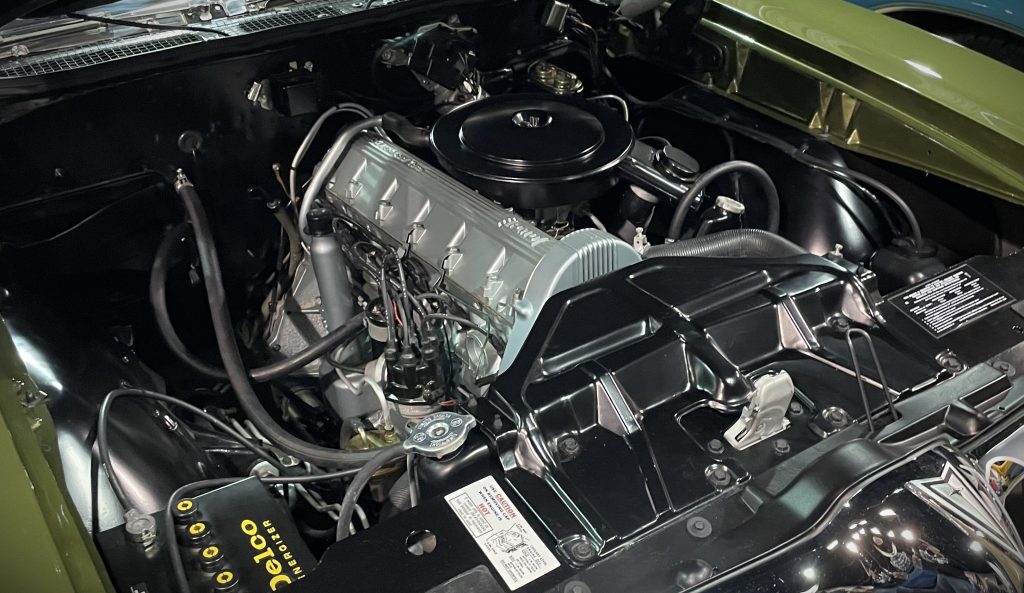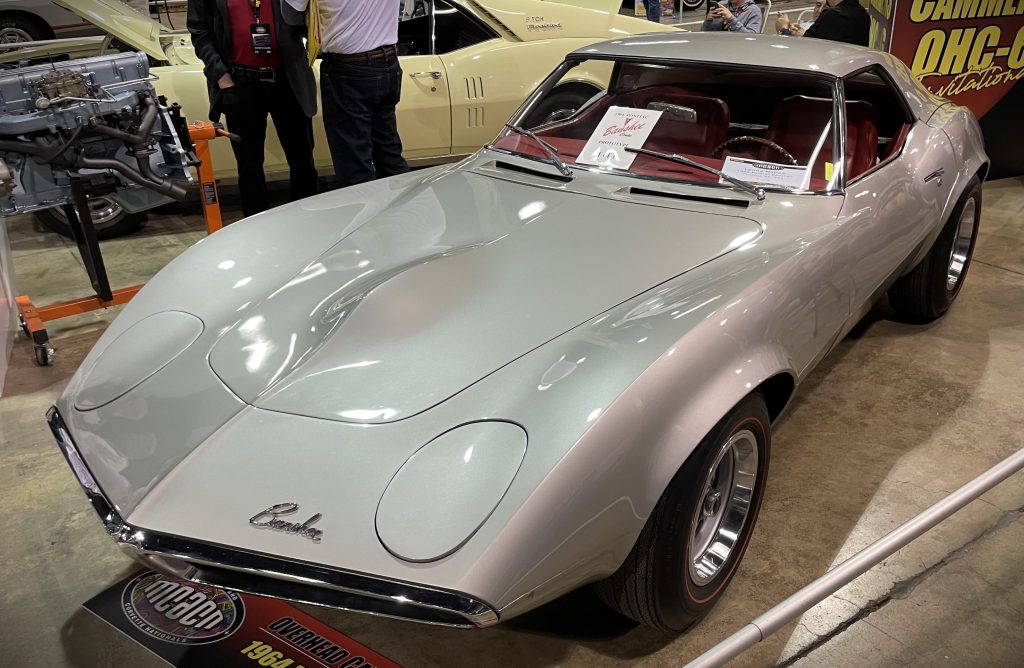In an earlier article on the Crosley Hotshot, we mentioned that it carried a groundbreaking engine with an overhead camshaft. That got us thinking about another innovative OHC powerplant that arrived over two decades later.
And when we saw a Montero Red Pontiac Tempest with the distinct “OHC 6 Sprint” badging at the 2021 Goodguys Summit Racing Nationals a few weeks ago, we figured now was a good time to tell you about it.
***
Story Summary Overview
- With the backing of John DeLorean, Pontiac developed an overhead cam inline 6 engine
- DeLorean drew inspiration from iconic European sports cars that featured potent OHC sixes
- The goal was to offer V8 performance with a more fuel-efficient engine
- The OHC 6 engines came in the A-body Tempest/Le Mans and Firebird models.
- Though the engines proved reliable, there was little desire in the 1960s market for fuel economy
- Pontiac only produced the OHC 6 engines from 1966-69, as interest in the motor waned
***

The OHC Inspiration
As with other performance-focused GM efforts like the Cosworth Vega and Pontiac GTO, the Sprint 6 story begins with John DeLorean.
And just like he did with the aforementioned GTO and Vega, DeLorean looked to Europe. He noted that cars like the Jaguar E-Type were powered by engines running overhead camshafts. This OHC design not only reduced the number of moving parts in the engine, it improved valvetrain performance and allowed for better valve sizing and spacing, which often meant a wider usable rev range and improved flow.
Always the engineer, DeLorean sought to develop a similar overhead cam engine that could create V8 power with less cylinders, in a lighter, more compact package.

Enter the Pontiac Overhead Cam Sixes
Starting with the basic engine architecture from Chevy’s inline six, Pontiac engineers pretty much reworked the entire thing. In addition to an all-new iron engine block, the Sprint 6 had a unique cylinder head that put a single, large 1.920″ intake and 1.600″ exhaust valve in each combustion chamber.
The camshaft, fuel pump, oil pump, and distributor were all driven off a fiberglass-reinforced Gilmer belt—a considerable innovation for the time. That arrangement also resulted in the Sprint 6’s signature ribbed timing belt cover that pops over the engine.

It’s also worth noting that the Pontiac OHC isn’t an interference engine, meaning that a broken or stretched belt wouldn’t necessarily result in contact between valves or the piston, avoiding catastrophic damage.
And it gets even more interesting when you look at the Sprint 6’s valve cover. It completely housed the single overhead camshaft within integrated journals, and the whole thing fit directly atop the cylinder head and valves. For valvetrain service, you disconnected the belt and removed the entire assembly just like a traditional valve cover.

Pontiac OHC & Sprint 6 Performance
It’s important to note that, while they all had the same overhead cam design, only the performance variants of the Pontiac OHC inline sixes got the “Sprint” name.
Base-trim OHC sixes were equipped with a single one-barrel carburetor and made around 130 horsepower. Sprint sixes benefitted from a hotter cam, Rochester Quadrajet, and a few other enhancements to push engine output well north of 200 horsepower.

In top fighting trim under the hood of a 1967 Firebird, the Sprint 6 made 215 hp. For comparison, the Firebird’s base 326 V8 was making 250 hp that same year. At its peak, the 1969 Sprint 6 topped out at 230 hp.
Famed tuning shop Royal Pontiac even offered a hop-up kit for the Sprint motors and, when tested on the drag strip, that extra performance could easily put you into the 14s.
The End of the Pontiac OHC Sixes

Despite some growing pains (oil starvation on the valvetrain being one of the biggest), these motors were showing that they could be capable and reliable performers. Yet, Pontiac only produced its OHC six engines from 1966 to 1969.
Why the short run? It was probably due to a confluence of issues, including mechanics’ unfamiliarity with the OHC design, high development costs, cheap gas negating the need for efficiency, and the overall perception that V8s offered inherently better performance (and to be fair, at that time, they did).

Though it’s fun to wonder what Pontiac’s overhead cam engines would have evolved into, given more development time. Perhaps the Sprint sixes would’ve propelled Pontiac through the gas crisis of the 1970s better than its nascent turbo V8? Perhaps an overhead camshaft engine could’ve turned the Fiero into the Ferrari fighter it should’ve been?
Regardless, these OHC Sprint engines are a fascinating footnote in Pontiac’s history—so at your next car show or cruise-in, be on the lookout for these powerplants under the hoods of first-gen Firebirds and 1966-69 Tempest/LeMans models.

[…] you’re into a dramatic-looking engine, consider the Pontiac Overhead Cam (OHC) inline six that came in the 1966-67 Tempest and 1967 Firebirds. These engines are very modern looking with the […]
I had a ’67 tempest w/ohc 6
Manual shift and AC.
I put Gabriel high jackers and chrome reverse rims on it.
Midas gold w/black painted top.
I rolled it over Thursday August 10, 1972.
I had a 66 sprint with a Muncie tranny and more than one small block owner learned it was quick!
Thank you for noticing our car. We had so many comments about keeping the car original.
This is a very nice article
I had 67 Lemans Sprint 6 4 speed post car. Drove over 120k miles but sold in 1975. It became difficult to find premium fuel at rural stations. (10.5 Cr dictated premium). My job required a lot of driving.
It was purchased in 68 as senior in college. I got Navy commission out of OSU. While on active duty it made many trips between Columbus and the coasts. Great car and fun to drive!
A “post” car?
Some of us know the difference between a 2 door hardtop and a 2 door sedan. Obviously you don’t.
We’ll stated…..for a condescending know-it-all. Sorry about your lack of life.
I bought a 1967 Lemans with the OHC6 back in the’80s. It was a bit dopey until I put a 4:11 rear under it. It woke it up considerably, and the OHC didn’t mind the high revs at all. It had the ST300 two-speed auto.
I bought a new 69 sprint with 3speed hurst. Loved it but sold it in 73. Last year bought a running sprint engine out of a 68 firebird that was being converted to retro mod. Still searching for a roller to put it in.
As mentioned in article, I also own a very rare Cosworth Vega #3241
I have a 66 tempest sprint with 3 speed on floor. Bought from original owner who got her groceries with it. 52000 miles. Had in storage for years now. Hoping to start a restoration on it next year.
Did you keep 66 Tempest Sprint? Did you restore?
Didn’t somebody develop a centrigal advance variable camshaft setup for these?
I have been think about centrifugal cam retard set up for years !
Have 69 Firebird convertible. Dad was original owner, stayed in family. 86,000 mi. Restored in 1982, original interior. 4 speed with higher torque rear end. Loaded with options…Dad was always trying to get something no one else had.
If you like or are interested in Pontiacs OHC 6 check out one of the Best forums on FB.
Did any one try to do a OHC on the “Iron Duke” 4 banger by Pontiac
Are you thinking about the Quad 4 engine series that came out around 1992? Those had overhead cams–you can learn more here.
Bought a 66 LeMans Sprint in 66 as a used vehicle. Had 23,000 miles on odometer. Color in blue with white convertible top. 3 speed Hurst. Loved that car. Wish I had kept it. Love the sound of the exhaust system. SUPER CAR!!!
Talked my parents into buying a new 1967 LeMans Sprint when I was in HS. 3 speed Hurst manual, gold exterior with black vinyl top & black Sprint racing stripe on lower body panels I loved the car. It also had unique reverbator switch for radio stereo effect. Unfortunately, parents had hard time driving it and traded for ’68 Chevy Impala a read dog of a
6 cylinder. Ha, ha.
I had a 68 Firebird sprint. I went through a quart of oil every half tank of gas and a valve job every two years that I had it(6 years).
I still have the ’69 Lemans sprint I bought new in April ’69. I put 3 weber carbs and long tube headers on it in 1971. I still have the car, and it still cleans up pretty good, as I never drove it in the winter. Has the OEM Muncie into which I installed an AutoGear wide ratio gearset, 2.98:1 first. Still love the car, as do others when I take it to shows.
When I was 16, I bought a ‘67 Sprint 6 Firebird from my dad who had bought it from my oldest brother who ordered it new. I paid $600 for it which was all it was worth at the time. Bright gold with the black deluxe interior, power steering, Rally wheels, F70-14 redline tires, and HD 3-spd with optional posi rear end.
I drove the piss out of it and won many drag races with small block V8 Fords and GM cars. It got 7 mpg on premium, and would float the valves after a couple hard runs and then take about 20 mins to recover.
I sold it to a friend who completely restored the car. He repainted, split the exhaust from the factory two into one header setup, and put a 4-speed in it. It was a great little car that would do smoky burnouts forever (we thought)!
I bought a 1966 Pontiac Tempest Sprint with the OHC 6 wand the Quadrajet carburator, and Hurst 3 speed shifter. The car was fun to drive, and as quick as the 326 V8 Tempest. But the quality was poor, and it spent a lot of time in the dealers garage. Later the engine burned the #1 exhaust valve.
Currently working on a 1966 Lemans Sprint OHC 6, two speed automatic transmission with factory air. The engine is tight locked up, I’m thinking about doing a LS swap but still keeping the original engine and transmission for rebuilding in the future. Still on the fence I have a LS4.8 with transmission that I can drop in. But I do have to admit the OHC is intriguing.
Had a ’67 Tempest OHC-6 with automatic. Never fun to drive – just basic transportation. LOTS of problems – burned exhaust valve, loose converter bolts, it just wasn’t anything you’d want. Gladly got rid of it for a ’68 Firebird 400 with the close ratio M-21 trans. Now that was excitement !! The Tempest is still the dull spot in decades of more interesting cars.
friend of mine had a 68 with the sprint six. We swapped in a four speed, found a larger rear end at the scrap yard. had true dual 2 1/4 inch exhaust with turbo mufflers. That car would wind up to 7000 rpm , sounded like a jaguar. He beat every 350 Camaro he went up against.